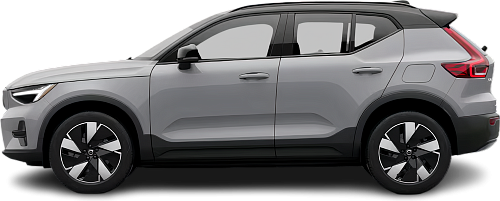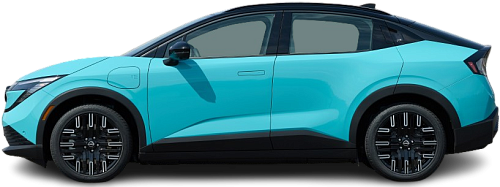Global EV Comparison: Volvo XC40 Recharge (EX40) Pure Electric vs Nissan Leaf 75 kWh
Struggling to Decide? Let AI Help!
Your AI Summary Is Ready!
General Info
Although the Nissan Leaf 75 kWh (2025-…) has been announced, it is not yet in production and will not be available for sale in Europe. The Volvo XC40 Recharge (EX40) Pure Electric (2022) has been discontinued. You can find it for as low as €30890 on the used car market.
The two vehicles share the same body style: SUV.
| Property | Volvo XC40 Recharge (EX40) Pure Electric | Nissan Leaf 75 kWh |
|---|---|---|
| Years of Production | 2022-2022 | 2025-… |
| Current Status | Discontinued | Announced |
| Country of Manufacture | Belgium | Japan, UK, USA |
| Body Style | SUV | SUV |
| Market Availability | EU | EU, USA |
| Price Europe (Used) | €30890 | - Price Europe (Used) |
| GCC Score | 6.1 | 5.9 |
Range and Efficiency
The Nissan Leaf 75 kWh (2025-…) boasts a greater real-world range, a larger battery, and superior energy efficiency compared to the Volvo XC40 Recharge (EX40) Pure Electric (2022).
| Property | Volvo XC40 Recharge (EX40) Pure Electric | Nissan Leaf 75 kWh |
|---|---|---|
| Range (EPA) | - Range (EPA) | 488 km |
| Range (WLTP) | 425 km | - Range (WLTP) |
| Range (GCC) | 366 km | 464 km |
| Battery Capacity (Nominal) | 69 kWh | 75 kWh |
| Battery Capacity (Usable) | 67 kWh | 71.2 kWh |
| Efficiency per 100 km | 18.3 kWh/100 km | 15.3 kWh/100 km |
| Efficiency per kWh | 5.46 km/kWh | 6.52 km/kWh |
| Range and Efficiency Score | 6.2 | 8.4 |
Charging
Both vehicles utilize a standard 400-volt architecture.
Both vehicles support DC fast charging with a maximum power of 150 kW.
The Volvo XC40 Recharge (EX40) Pure Electric (2022) features a more powerful on-board charger, supporting a maximum AC charging power of 11 kW, whereas the Nissan Leaf 75 kWh (2025-…) is limited to 7.2 kW.
| Property | Volvo XC40 Recharge (EX40) Pure Electric | Nissan Leaf 75 kWh |
|---|---|---|
| Max Charging Power (AC) | 11 kW | 7.2 kW |
| Max Charging Power (DC) | 150 kW | 150 kW |
| Architecture | 400 V | 400 V |
| Charge Port | CCS Type 2 | CCS Type 2 |
| Charging Score | 6.1 | 5.1 |
Performance
Both vehicles are front-wheel drive.
Although the Volvo XC40 Recharge (EX40) Pure Electric (2022) has more power, the Nissan Leaf 75 kWh (2025-…) achieves a faster 0-100 km/h time.
| Property | Volvo XC40 Recharge (EX40) Pure Electric | Nissan Leaf 75 kWh |
|---|---|---|
| Drive Type | FWD | FWD |
| Motor Type | PMSM | PMSM |
| Motor Power (kW) | 170 kW | 160 kW |
| Motor Power (hp) | 228 hp | 214 hp |
| Motor Torque | 330 Nm | 354 Nm |
| 0-100 km/h | 7.4 s | 7.1 s |
| Top Speed | 160 km/h | 157 km/h |
| Performance Score | 3.6 | 3.7 |
Dimensions
The Volvo XC40 Recharge (EX40) Pure Electric (2022) is wider and taller, but about the same length as the Nissan Leaf 75 kWh (2025-…).
Both models have similar wheelbase lengths.
| Property | Volvo XC40 Recharge (EX40) Pure Electric | Nissan Leaf 75 kWh |
|---|---|---|
| Length | 4425 mm | 4405 mm |
| Width (with Mirrors) | 2034 mm | 2099 mm |
| Width (w/o Mirrors) | 1873 mm | 1810 mm |
| Height | 1652 mm | 1557 mm |
| Wheelbase | 2702 mm | 2690 mm |
Cargo and Towing
The Nissan Leaf 75 kWh (2025-…) provides more cargo capacity, featuring both a larger trunk and more space with the rear seats folded.
A frunk (front trunk) is available in the Volvo XC40 Recharge (EX40) Pure Electric (2022), but the Nissan Leaf 75 kWh (2025-…) doesn’t have one.
The Volvo XC40 Recharge (EX40) Pure Electric (2022) has a towing capacity of up to 1500 kg, whereas the Nissan Leaf 75 kWh (2025-…) is not officially rated for towing in the EU.
| Property | Volvo XC40 Recharge (EX40) Pure Electric | Nissan Leaf 75 kWh |
|---|---|---|
| Number of Seats | 5 | 5 |
| Curb Weight | 2030 kg | 1899 kg |
| Cargo Volume (Trunk) | 410 l | 565 l |
| Cargo Volume (Max) | 1295 l | 1573 l |
| Cargo Volume (Frunk) | 31 l | - Cargo Volume (Frunk) |
| Towing Capacity | 1500 kg | - Towing Capacity |
| Cargo and Towing Score | 6.7 | 5.8 |




